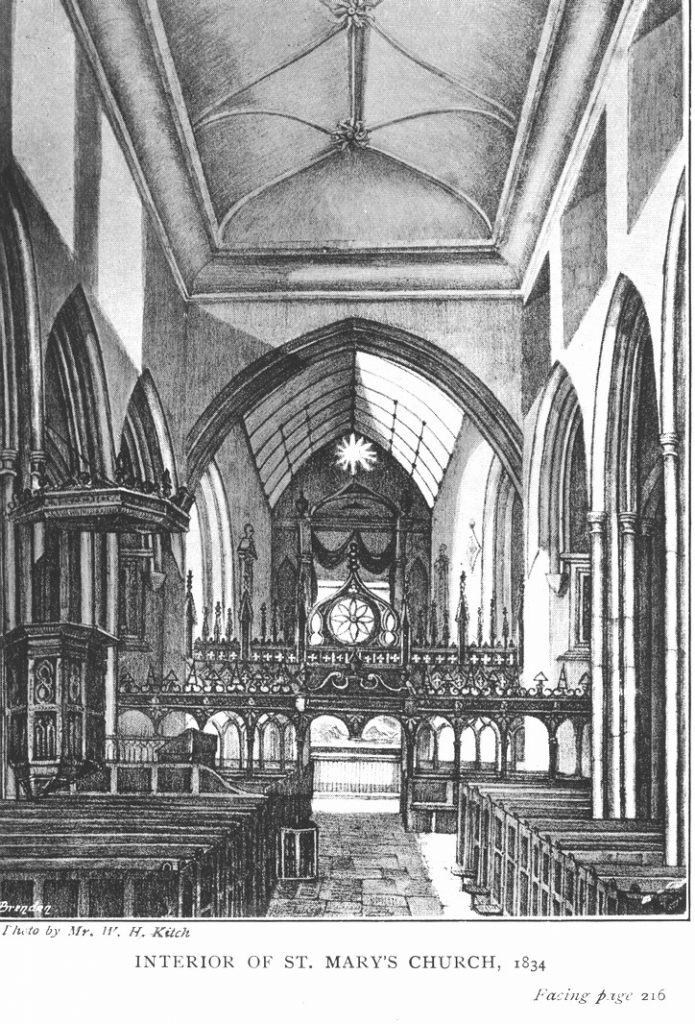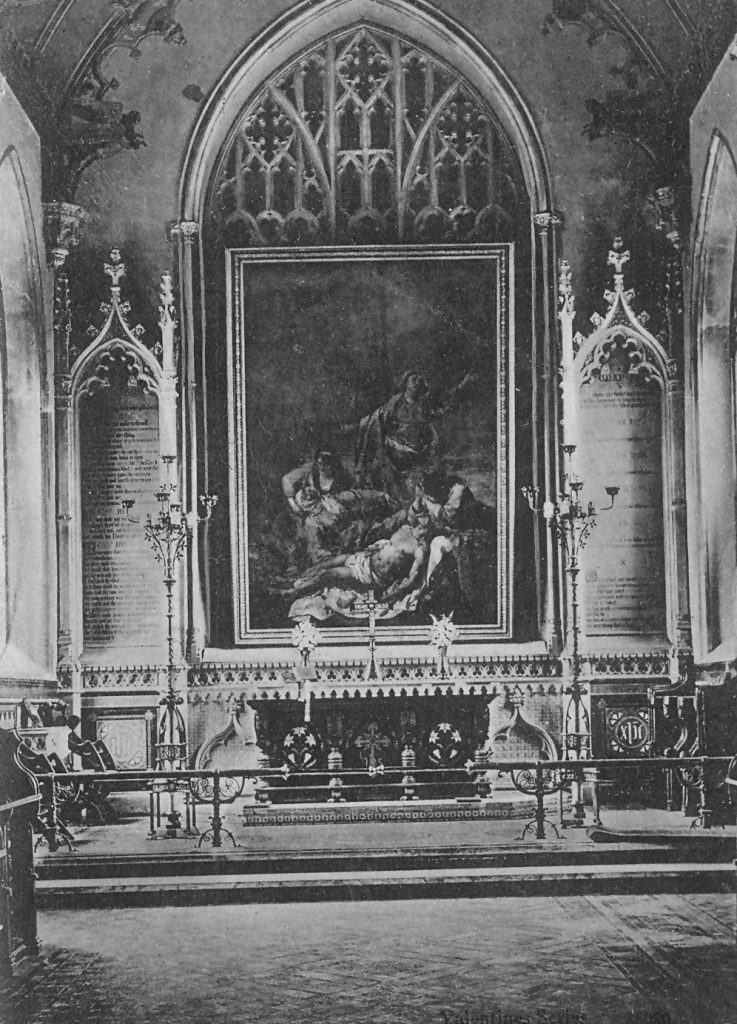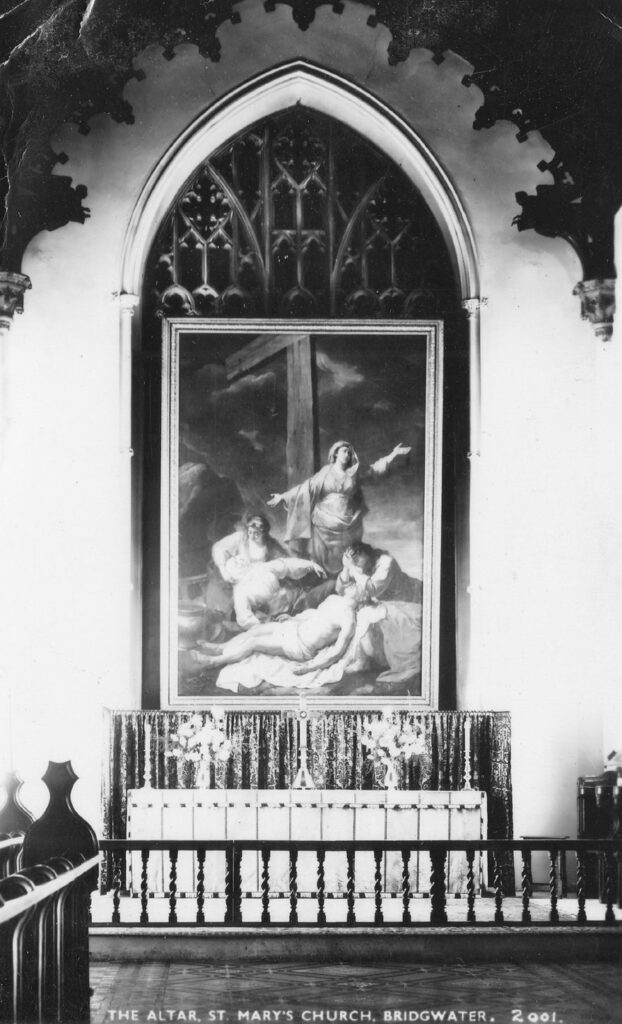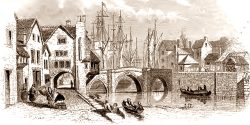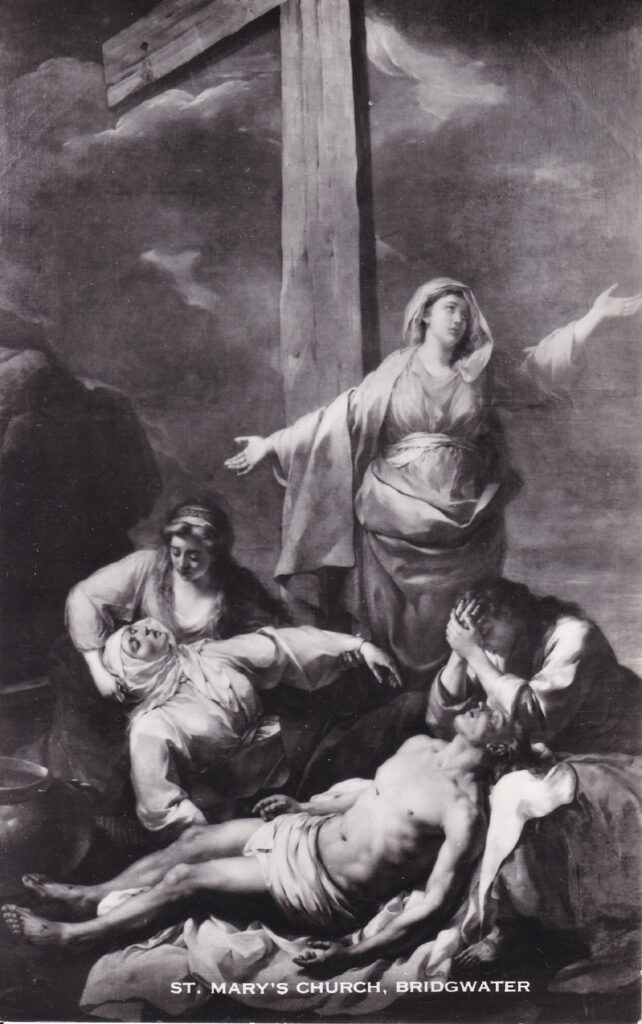
Symbolism
The Descent from the Cross (Greek: Ἀποκαθήλωσις, Apokathelosis), or Deposition of Christ, is the scene, as depicted in art, from the Gospels’ accounts of Joseph of Arimathea and Nicodemus taking Christ down from the cross after his crucifixion (John 19:38–42).
NIV The Burial of Jesus
38 Later, Joseph of Arimathea asked Pilate for the body of Jesus. Now Joseph was a disciple of Jesus, but secretly because he feared the Jewish leaders. With Pilate’s permission, he came and took the body away. 39 He was accompanied by Nicodemus, the man who earlier had visited Jesus at night. Nicodemus brought a mixture of myrrh and aloes, about seventy-five pounds. 40 Taking Jesus’ body, the two of them wrapped it, with the spices, in strips of linen. This was in accordance with Jewish burial customs. 41 At the place where Jesus was crucified, there was a garden, and in the garden a new tomb, in which no one had ever been laid. 42 Because it was the Jewish day of Preparation and since the tomb was nearby, they laid Jesus there.
The Descent from the Cross is the 13th Station of the Cross, and is also the sixth of the Seven Sorrows of the Blessed Virgin Mary. In Byzantine art the topic became popular in the 9th century, and in the West from the 10th century. Google images has a big range of pictures.
Other figures not mentioned in the Gospels who are often included in depictions of this subject include John the Evangelist, who is sometimes depicted supporting a fainting Mary and Mary Magdalene. The Gospels mention an undefined number of women as watching the crucifixion, including The Three Marys, (Mary Salome being mentioned in Mark 15:40), and also that the Virgin Mary and Mary Magdalene saw the burial (Mark 15:47). These and further women and unnamed male helpers are often shown.

The Bridgwater picture shows Our Lord at the foot of the Cross (1) with St John (4) bending over Him, the Madonna (2) is supported in the arms of a friend (5) and Mary Magdalene (3) is standing by.
Note that this is a rare depiction of Christ as an adult without a beard.
Tony Woolrich, 12 July 2021
History
Listing particulars Somerset HER 14945
On east wall of chancel is a painting of The Descent from the Cross, attributed to Murillo and given to the church in C18 by Mr Pawlett of Hinton St George.
Robert Dunning, A History of the County of Somerset: Volume 6, 1992
“The east window of the sanctuary is blocked by a painting, given in 1780 by Anne Poulett, which he acquired from a Spanish ship taken as a prize. (fn. 137) It may be Bolognese, of the later 17th century. (fn. 138)”
Footnote 137 is Proc. Som. Arch. Soc. lxvi, (1920) p. xxiii., which is as follows:
“Mr. Bond added that the Vicar of Bridgwater gave the following note on the picture of the “Descent from the Cross ” over the altar :-The picture was presented to the town in 1780 by .Lord Anne Poulett, member for Bridgwater. He purchased it in Plymouth from the contents of a prize-ship which was then in Plymouth Harbour. It had been taken from its frame, rolled up and carried thus to Bridgwater. This was stated on the authority of a grandson of the man who unpacked it on its arrival. The artist of the picture was unknown, but experts generally assigned it to the Spanish school, and a strong opinion had been expressed that it was a Murillo. This view was shared by Dr. Russell Forbes of Rome, who had also stated his belief that the figure of the Blessed Mary was painted from the same model as one or two of Murillo’s representations of her in pictures at Rome.”
Footnote 138 is Pevsner, S. & W. Som. 96.
Note that Dunning also asserts in his Bridgwater History and Guide, that the painting was placed above the altar in 1775, p.58.
Jack Lawrence, St Mary’s Bridgwater: The Story of an Historic Church, 1972
We have seen how the church was practically re-designed after 1850 so that the huge painting, Descent from the Cross, which covers the east window, should dominate the church. We know that this picture was bought in Plymouth by the Hon. Anne Poulett at a sale of naval prizes. Presumably it had been taken from a French or a Spanish privateer during the American War of Independence. The capture might well have been made in the Mediterranean. It is a minor master-piece by an unknown artist. The latest theory is that it was the work of Ludovico Stern, a German artist who worked in Rome in the late 18th century. Before he died in 1785, Mr. Poulett presented the painting to the town. From 1768 until his death he had been a Member of Parliament for Bridgwater.
The King’s England volume Somerset Arthur Mee 1941, transcribed by David Cronin
So rich a church should have a treasure at its altar, and the altar of St Mary’s is a treasure indeed. It is a great French master’s conception of the Descent from the Cross, so big it covers up the east window as far as the tracery, and so fine that it is said that Sir Joshua Reynolds broke his long coach journeys between London and Plymouth to sit and look at it. The picture shows Our Lord at the foot of the Cross with St John bending over Him, the Madonna is supported in the arms of a friend and Mary Magdalene standing by. It brings before us the pity and pathos of Calvary and these five figures are the work of a very great master. Nobody knows who the artist is but the picture is apparently 17th century.
What we do know of it is that it came here in a curious way, for it is a work of art of strange adventures. During the French Revolution one of our men-of-war ran down a Spanish privateer bound for San Domingo and this picture was on board. It was brought to England and Lord Anne Poulett (so oddly named because he was a godson of Queen Anne) obtained it and gave it to Bridgwater. It is said his gift was not appreciated and that it remained unpacked for two years, but in the end found its way to St Mary’s and is without rival as an altarpiece in Somerset.
SANHS XLIII 1897 p17
With regard to the furniture, the most conspicuous thing was the picture presented to the church by Mr Anne Poulet, who was christened Anne after Queen Anne, and was at that time member for Bridgwater. Beyond that fact no history of the picture was known, but it was generally ascribed to an Italian artist, Annibale Carracci, of Bologna.
The Story of St Mary’s Church TB Dilks 6 Edition nd (prob. ca. 1955), p16
We do know something of the story of this great picture, though we do not know the secret of its origin. That is hidden from us. Even what we do know is not based entirely on documentary authority, but partly on tradition. It has been handed down that Lord Anne Poulett, being at Plymouth, was present at the dispersal of the spoils of a prize taken in the wars which were waged in the earlier years of the reign of George the Third. Among them was this picture, though whence it came we do not know. Lord Anne bought it and eventually gave it to Bridgwater and the gift must have been made in or before 1785, the year in which he died. And that is all we know. Who was the creator of this great work of art? There is no final consensus of opinion on the answer to this question, though all the critics are agreed on the magnificence of the work. Much can besaid in favour of attributing the picture to the brush of Murillo. Dr. Russell Forbes has pointed out the strong likeness existing between two of the women in this picture – the standing figure and the woman supporting our Lord’s head – and those in The Adoration of St Catherine, apart from the colour, manner and naturalness of the composition. Other critics will not allow that it is even Spanish, let alone Murillo’s. According to them it is more like the work of Tiepolo or of his school, while Von Hadeln, the author of The Drawings of G. B. Tiepolo, altogether rejects the idea of it being produced by that artist. After all, what does it really matter whether it is the work of Caracer or Le Seuer, of Guido, or Tiepolo, or of Murillo! p23 The picture has been cleaned by an expert artist. Yet one more opinion on the date of the great picture, that of a distinguished German expert, may be added. The work may be placed, he judged, about 1650, but not more than twenty years earlier.
A Handbook of St Mary’s Church Bridgwater, Jarman S.G. 1885
One of the principal features of the church is the magnificent and renowned painting (measuring 13ft by 8ft), which now serves as an altar piece. It represents “The Descent from the Cross “, with John, the beloved disciple, leaning mournfully over the body of Christ, in the anguish of silent grief. Near the feet of Jesus the Virgin Mary has fainted in the arms of Mary Magdalene, who hangs over her with a mingled expression of grief, dismay, and tender affection; and near the head is perhaps the most striking figure of the group, Mary, the wife of Cleophas, kneeling, her arm extended, a tear falling from her cheek, and the whole attitude finely expressive of her breathing a prayer to heaven. The subject is not treated with that fervid, vivid imagination which a modern artist might have called to his aid, but there is a great amount of quiet, eloquent beauty about the picture. the choice of colour, the tone, the manipulation, are all faultless. It has often attracted men such as Sir Joshua Reynolds, and the latter has been known to have remained some hours in the church studying it.
Unfortunately the name of the gifted painter is shrouded in obscurity, and very little is known of even the circumstances under which it was placed in the church. It is believed to have been taken out of a French or Spanish privateer during the last war with France, and sold as a prize at Plymouth by auction, where it was purchased by the Hon. Lord Anne Poulett (named after Queen Anne, who was his godmother), who represented the town in Parliament for many years, and who presented the picture to the town thus honouring him.
There are diverse opinions as to whether it is of the Spanish or Italian school. The Right Rev. Bishop Clifford considers it to be the latter, remembering a similar work by an Italian artist. Haydon, the painter, expressed the same opinion, although the style of the hair and the blue band across it, suggest the possibility of its being a Spanish work. Be that as it may, the picture is an interesting and very valuable one, and has attracted more than one good offer. The inhabitants, however, have very naturally declined to part with their prize, although an effort was once made to purchase it with a view to its being placed in the British Museum.
About fifty years ago it became evident that the picture required cleaning. By Haydon’s advice the picture was sent to London and carefully cleaned of its accumulated dust and local varnish. The work cost about £50, but it was money well laid out, and the picture was returned in what was believed to be its pristine beauty. It was also cleaned and varnished about 28 or 29 years ago, an artist being engaged to do the work in the church. The picture was removed by Mr King (one of the present ringers) and three others. two splendid copies of this picture have been made by Mr A Squibbs, photographic artist, of queen Street, Bridgwater: one, an oil painting, is in the possession of Mr S Chapman, one of the churchwardens. Mr Squibbs has also produced photographs of the picture.
During the years 1849 to 1853 inclusive ….the eastern window, together with the tablets, were presented by Samuel James Remnant. An entrance which existed at the western end was filled up, in consequence of the architect’s report that the structure was unsafe, and that the tower and spire must henceforth be pulled down!. The (tower) wall was levelled and plastered in order to hang the large and beautiful picture now over the altar, it being thought that it would show to better advantage. This was found to be a great mistake, and after a short time Mr James, the then vicar, determined to restore it to its former position over the altar, but for some unaccountable reason a spirit of opposition manifested itself in the town, and a threat was made to riddle the work of art with bullets if it were removed. By the advice of Mr R. C. Else the picture was lined with iron in order to render it more secure, and it was then placed where now seen.
The Ancient History of Bridgwater Parker G 1877 p36
The altar-piece is a very valuable painting, second to none known as a work of art. It has been examined by Sir Joshua Reynolds, Haydon and other eminent painters, but none of them have been able to speak with certainty as to the name of the artist. It was taken during a war with France out of a French vessel brought as a prize into Plymouth, there purchased by Lord Powlett (it was said that Queen Ann was his godmother), and presented to the town of Bridgwater by his lordship. the subject is Christ taken from the Cross; St John leaning mournfully over the body of the dead Saviour; the Virgin Mary fainting; Mary the wife of Cleophas holding the Virgin’s head; and perhaps the most beautifully executed of all the figures is Mary Magdalene, with grief strongly depicted on her countenance, standing with one arm extended, the hand exquisitely pourtrayed (sic), and a tear rolling from her cheek. It forms altogether a picture as a work of art invaluable. It has been doubted whether it is a Spanish or an Italian painting, but the preponderance of opinion inclines to the latter.
J Brit Arch Soc 1856,12, 375
The church of St Mary was visited, in which various restorations have been attempted; but much remains to be done. Viewed from the east end an unsightly mass of masonry presents itself; and a peculiarly ugly vestry-room has been appended to the building. The east window is blocked up to admit a large picture of the descent from the cross, obtained from a vessel taken as a prize during the war with France, and presented to the town by a member of the Poulett family. It is of considerable merit; but the artist is unknown. He was of the Italian school.
Edmund Rack’s Survey of Somerset 1781
The altar piece is an admirable painting of Raphael’s. This subject is Our Saviour just taken from the cross. This painting is 8ft wide and 13 high, in a very elegant gilded and carved frame surrounded by a very elegant emblematical figures in plaister of Paris on a dove coloured and blue ground. On each side of this painting are very handsome clustered pillars in stucco with Corinthian capitals terminated by two superb flaming urn[s] girt with gilded foliage [f. 24/6] This altar piece was given by th Hon. Ann Paulet, Member for this borough, in the year [blank]
Additional Notes
The picture may also be described as The Lamentation of Christ.
Anne Poulett was a known collector of fine paintings.
The Collection of the Honorable Anne Poulett contained A Family Group by van Dyck 1634/35
A second, identical, but smaller picture, measuring 80cm x 118cm, oil on canvas, was recently sold in Florence. That is assumed to be contemporary, c.1700, and from the same studio as the Bridgwater picture.
Dr Peter Cattermole 7 February 2009 revised 8 June 2011 and 13 November 2011. Additional notes by MKP
Images In Situ
